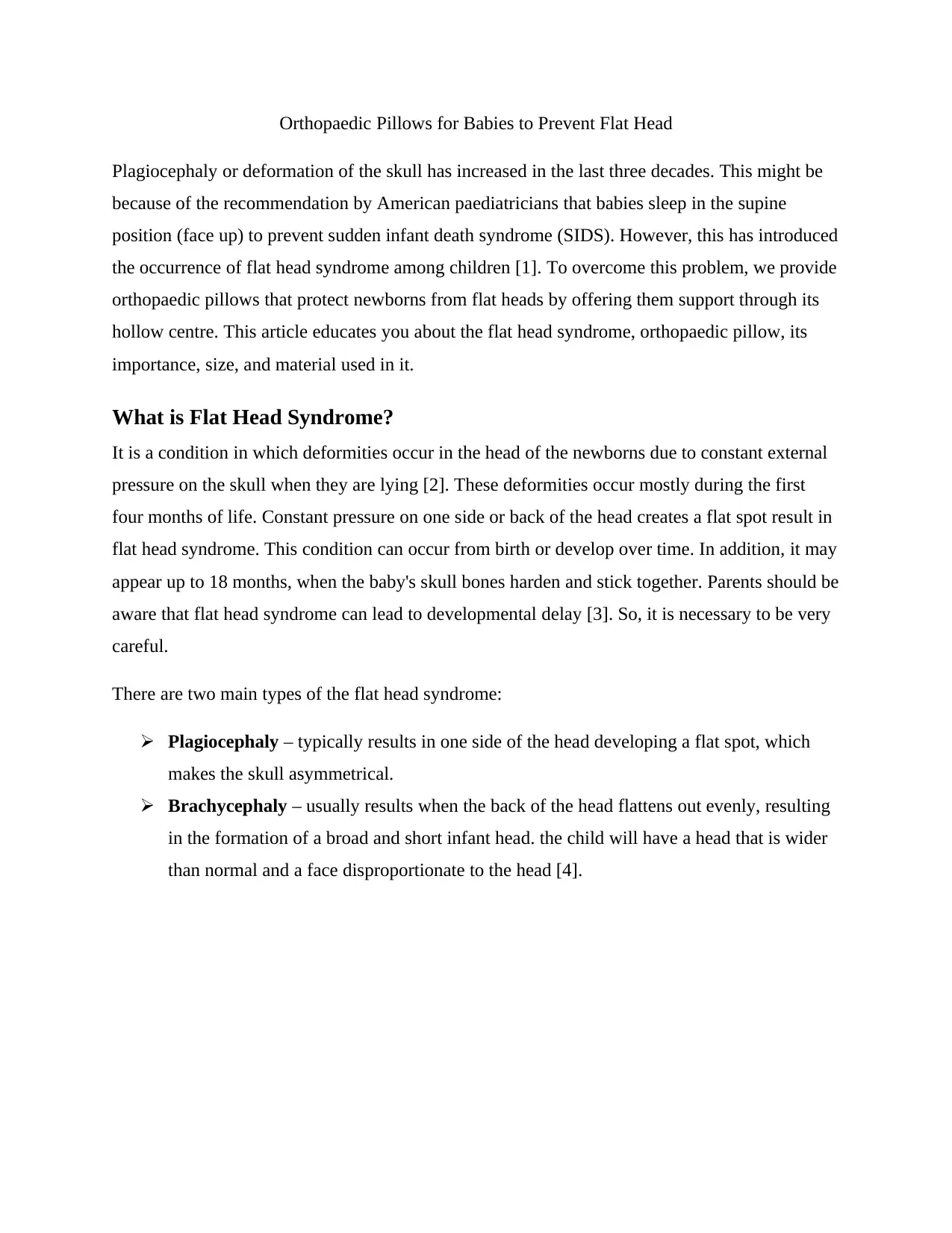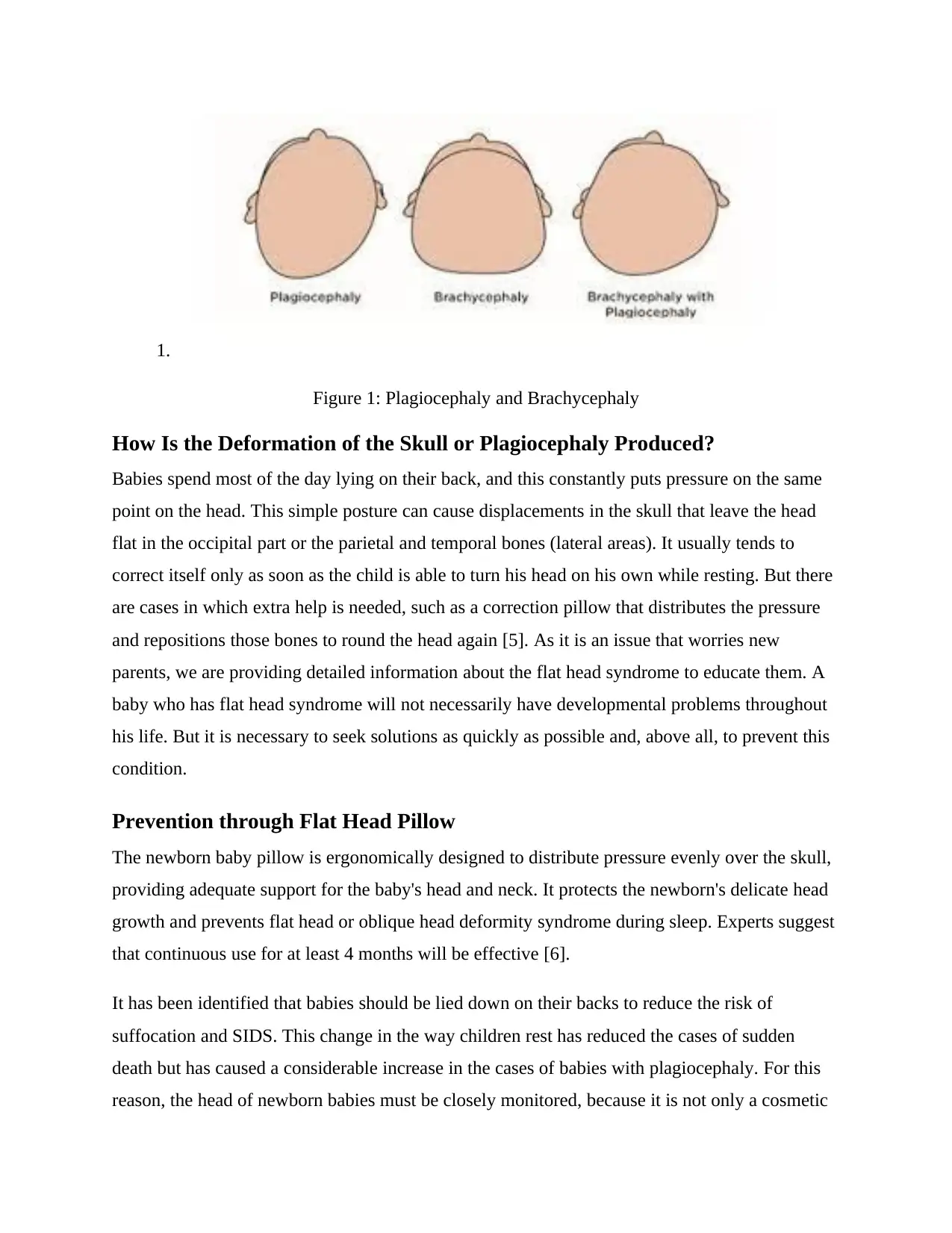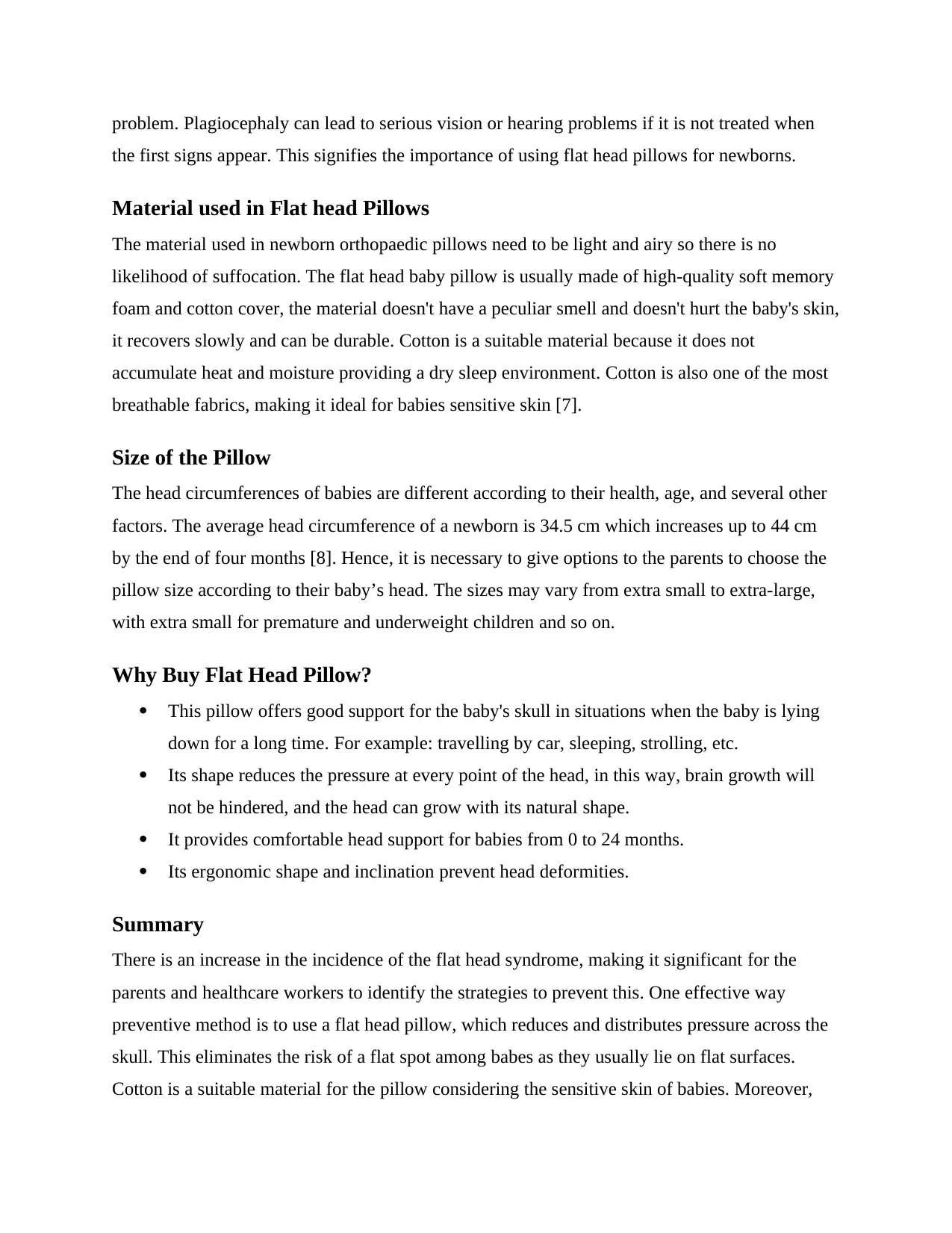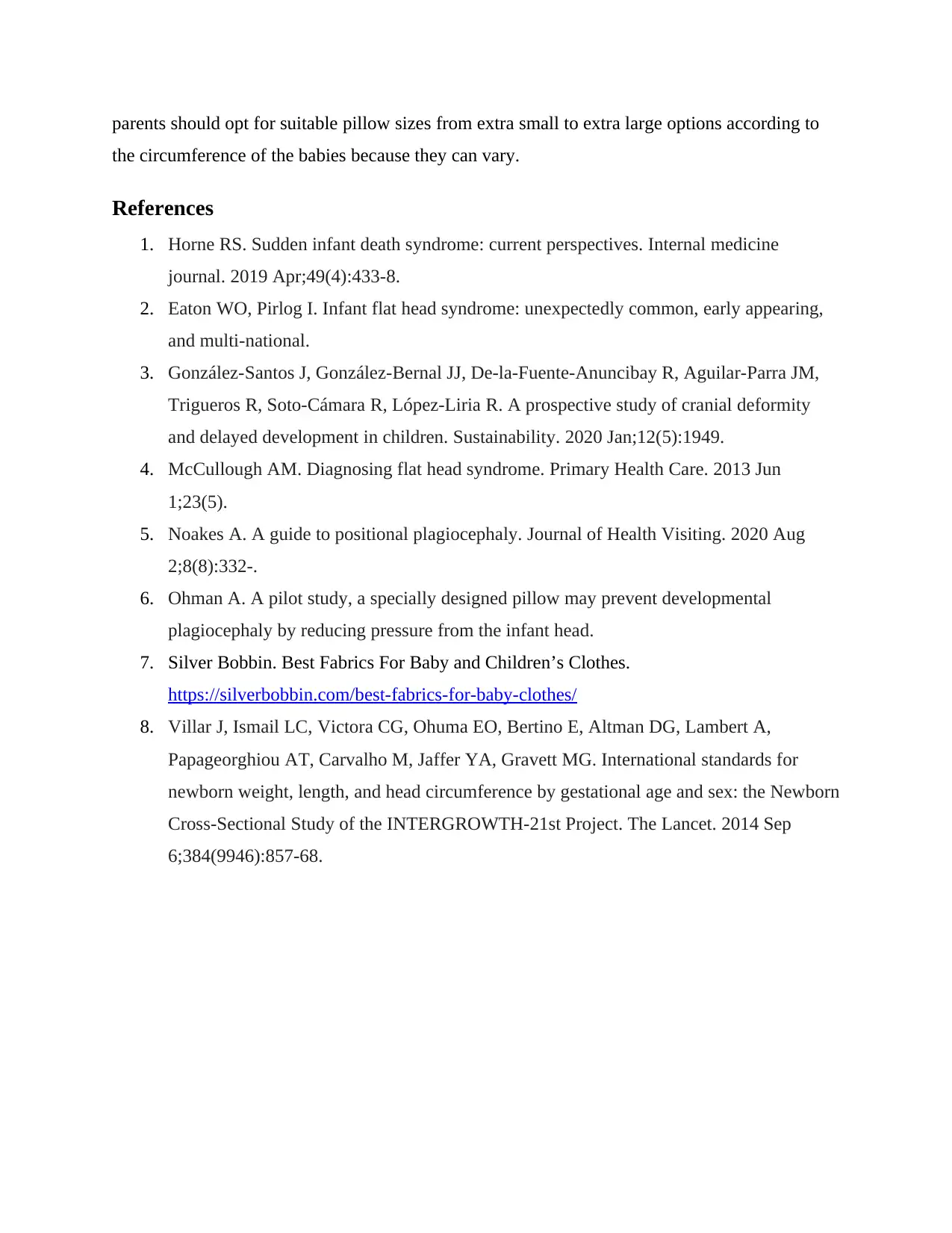Orthopaedic Pillows for Babies: Flat Head Syndrome Prevention Report
VerifiedAdded on 2022/02/04
|5
|1346
|387
Report
AI Summary
This report addresses the increasing incidence of flat head syndrome (plagiocephaly and brachycephaly) in infants, often linked to the supine sleeping position recommended to prevent Sudden Infant Death Syndrome (SIDS). It highlights the role of orthopaedic pillows in preventing and managing this condition by evenly distributing pressure on the baby's skull. The report explains the types of flat head syndrome, the importance of early intervention, and the materials used in these pillows, such as memory foam and cotton. It also emphasizes the significance of selecting appropriate pillow sizes based on the baby's head circumference and provides guidance on the benefits of using these pillows to support healthy head growth and development. The report also highlights the importance of choosing the correct size based on the baby's head circumference. The report concludes by emphasizing the importance of prevention to avoid vision and hearing problems. The report is based on published medical literature.

Orthopaedic Pillows for Babies to Prevent Flat Head
Plagiocephaly or deformation of the skull has increased in the last three decades. This might be
because of the recommendation by American paediatricians that babies sleep in the supine
position (face up) to prevent sudden infant death syndrome (SIDS). However, this has introduced
the occurrence of flat head syndrome among children [1]. To overcome this problem, we provide
orthopaedic pillows that protect newborns from flat heads by offering them support through its
hollow centre. This article educates you about the flat head syndrome, orthopaedic pillow, its
importance, size, and material used in it.
What is Flat Head Syndrome?
It is a condition in which deformities occur in the head of the newborns due to constant external
pressure on the skull when they are lying [2]. These deformities occur mostly during the first
four months of life. Constant pressure on one side or back of the head creates a flat spot result in
flat head syndrome. This condition can occur from birth or develop over time. In addition, it may
appear up to 18 months, when the baby's skull bones harden and stick together. Parents should be
aware that flat head syndrome can lead to developmental delay [3]. So, it is necessary to be very
careful.
There are two main types of the flat head syndrome:
Plagiocephaly – typically results in one side of the head developing a flat spot, which
makes the skull asymmetrical.
Brachycephaly – usually results when the back of the head flattens out evenly, resulting
in the formation of a broad and short infant head. the child will have a head that is wider
than normal and a face disproportionate to the head [4].
Plagiocephaly or deformation of the skull has increased in the last three decades. This might be
because of the recommendation by American paediatricians that babies sleep in the supine
position (face up) to prevent sudden infant death syndrome (SIDS). However, this has introduced
the occurrence of flat head syndrome among children [1]. To overcome this problem, we provide
orthopaedic pillows that protect newborns from flat heads by offering them support through its
hollow centre. This article educates you about the flat head syndrome, orthopaedic pillow, its
importance, size, and material used in it.
What is Flat Head Syndrome?
It is a condition in which deformities occur in the head of the newborns due to constant external
pressure on the skull when they are lying [2]. These deformities occur mostly during the first
four months of life. Constant pressure on one side or back of the head creates a flat spot result in
flat head syndrome. This condition can occur from birth or develop over time. In addition, it may
appear up to 18 months, when the baby's skull bones harden and stick together. Parents should be
aware that flat head syndrome can lead to developmental delay [3]. So, it is necessary to be very
careful.
There are two main types of the flat head syndrome:
Plagiocephaly – typically results in one side of the head developing a flat spot, which
makes the skull asymmetrical.
Brachycephaly – usually results when the back of the head flattens out evenly, resulting
in the formation of a broad and short infant head. the child will have a head that is wider
than normal and a face disproportionate to the head [4].
Paraphrase This Document
Need a fresh take? Get an instant paraphrase of this document with our AI Paraphraser

1.
Figure 1: Plagiocephaly and Brachycephaly
How Is the Deformation of the Skull or Plagiocephaly Produced?
Babies spend most of the day lying on their back, and this constantly puts pressure on the same
point on the head. This simple posture can cause displacements in the skull that leave the head
flat in the occipital part or the parietal and temporal bones (lateral areas). It usually tends to
correct itself only as soon as the child is able to turn his head on his own while resting. But there
are cases in which extra help is needed, such as a correction pillow that distributes the pressure
and repositions those bones to round the head again [5]. As it is an issue that worries new
parents, we are providing detailed information about the flat head syndrome to educate them. A
baby who has flat head syndrome will not necessarily have developmental problems throughout
his life. But it is necessary to seek solutions as quickly as possible and, above all, to prevent this
condition.
Prevention through Flat Head Pillow
The newborn baby pillow is ergonomically designed to distribute pressure evenly over the skull,
providing adequate support for the baby's head and neck. It protects the newborn's delicate head
growth and prevents flat head or oblique head deformity syndrome during sleep. Experts suggest
that continuous use for at least 4 months will be effective [6].
It has been identified that babies should be lied down on their backs to reduce the risk of
suffocation and SIDS. This change in the way children rest has reduced the cases of sudden
death but has caused a considerable increase in the cases of babies with plagiocephaly. For this
reason, the head of newborn babies must be closely monitored, because it is not only a cosmetic
Figure 1: Plagiocephaly and Brachycephaly
How Is the Deformation of the Skull or Plagiocephaly Produced?
Babies spend most of the day lying on their back, and this constantly puts pressure on the same
point on the head. This simple posture can cause displacements in the skull that leave the head
flat in the occipital part or the parietal and temporal bones (lateral areas). It usually tends to
correct itself only as soon as the child is able to turn his head on his own while resting. But there
are cases in which extra help is needed, such as a correction pillow that distributes the pressure
and repositions those bones to round the head again [5]. As it is an issue that worries new
parents, we are providing detailed information about the flat head syndrome to educate them. A
baby who has flat head syndrome will not necessarily have developmental problems throughout
his life. But it is necessary to seek solutions as quickly as possible and, above all, to prevent this
condition.
Prevention through Flat Head Pillow
The newborn baby pillow is ergonomically designed to distribute pressure evenly over the skull,
providing adequate support for the baby's head and neck. It protects the newborn's delicate head
growth and prevents flat head or oblique head deformity syndrome during sleep. Experts suggest
that continuous use for at least 4 months will be effective [6].
It has been identified that babies should be lied down on their backs to reduce the risk of
suffocation and SIDS. This change in the way children rest has reduced the cases of sudden
death but has caused a considerable increase in the cases of babies with plagiocephaly. For this
reason, the head of newborn babies must be closely monitored, because it is not only a cosmetic

problem. Plagiocephaly can lead to serious vision or hearing problems if it is not treated when
the first signs appear. This signifies the importance of using flat head pillows for newborns.
Material used in Flat head Pillows
The material used in newborn orthopaedic pillows need to be light and airy so there is no
likelihood of suffocation. The flat head baby pillow is usually made of high-quality soft memory
foam and cotton cover, the material doesn't have a peculiar smell and doesn't hurt the baby's skin,
it recovers slowly and can be durable. Cotton is a suitable material because it does not
accumulate heat and moisture providing a dry sleep environment. Cotton is also one of the most
breathable fabrics, making it ideal for babies sensitive skin [7].
Size of the Pillow
The head circumferences of babies are different according to their health, age, and several other
factors. The average head circumference of a newborn is 34.5 cm which increases up to 44 cm
by the end of four months [8]. Hence, it is necessary to give options to the parents to choose the
pillow size according to their baby’s head. The sizes may vary from extra small to extra-large,
with extra small for premature and underweight children and so on.
Why Buy Flat Head Pillow?
This pillow offers good support for the baby's skull in situations when the baby is lying
down for a long time. For example: travelling by car, sleeping, strolling, etc.
Its shape reduces the pressure at every point of the head, in this way, brain growth will
not be hindered, and the head can grow with its natural shape.
It provides comfortable head support for babies from 0 to 24 months.
Its ergonomic shape and inclination prevent head deformities.
Summary
There is an increase in the incidence of the flat head syndrome, making it significant for the
parents and healthcare workers to identify the strategies to prevent this. One effective way
preventive method is to use a flat head pillow, which reduces and distributes pressure across the
skull. This eliminates the risk of a flat spot among babes as they usually lie on flat surfaces.
Cotton is a suitable material for the pillow considering the sensitive skin of babies. Moreover,
the first signs appear. This signifies the importance of using flat head pillows for newborns.
Material used in Flat head Pillows
The material used in newborn orthopaedic pillows need to be light and airy so there is no
likelihood of suffocation. The flat head baby pillow is usually made of high-quality soft memory
foam and cotton cover, the material doesn't have a peculiar smell and doesn't hurt the baby's skin,
it recovers slowly and can be durable. Cotton is a suitable material because it does not
accumulate heat and moisture providing a dry sleep environment. Cotton is also one of the most
breathable fabrics, making it ideal for babies sensitive skin [7].
Size of the Pillow
The head circumferences of babies are different according to their health, age, and several other
factors. The average head circumference of a newborn is 34.5 cm which increases up to 44 cm
by the end of four months [8]. Hence, it is necessary to give options to the parents to choose the
pillow size according to their baby’s head. The sizes may vary from extra small to extra-large,
with extra small for premature and underweight children and so on.
Why Buy Flat Head Pillow?
This pillow offers good support for the baby's skull in situations when the baby is lying
down for a long time. For example: travelling by car, sleeping, strolling, etc.
Its shape reduces the pressure at every point of the head, in this way, brain growth will
not be hindered, and the head can grow with its natural shape.
It provides comfortable head support for babies from 0 to 24 months.
Its ergonomic shape and inclination prevent head deformities.
Summary
There is an increase in the incidence of the flat head syndrome, making it significant for the
parents and healthcare workers to identify the strategies to prevent this. One effective way
preventive method is to use a flat head pillow, which reduces and distributes pressure across the
skull. This eliminates the risk of a flat spot among babes as they usually lie on flat surfaces.
Cotton is a suitable material for the pillow considering the sensitive skin of babies. Moreover,
⊘ This is a preview!⊘
Do you want full access?
Subscribe today to unlock all pages.

Trusted by 1+ million students worldwide

parents should opt for suitable pillow sizes from extra small to extra large options according to
the circumference of the babies because they can vary.
References
1. Horne RS. Sudden infant death syndrome: current perspectives. Internal medicine
journal. 2019 Apr;49(4):433-8.
2. Eaton WO, Pirlog I. Infant flat head syndrome: unexpectedly common, early appearing,
and multi-national.
3. González-Santos J, González-Bernal JJ, De-la-Fuente-Anuncibay R, Aguilar-Parra JM,
Trigueros R, Soto-Cámara R, López-Liria R. A prospective study of cranial deformity
and delayed development in children. Sustainability. 2020 Jan;12(5):1949.
4. McCullough AM. Diagnosing flat head syndrome. Primary Health Care. 2013 Jun
1;23(5).
5. Noakes A. A guide to positional plagiocephaly. Journal of Health Visiting. 2020 Aug
2;8(8):332-.
6. Ohman A. A pilot study, a specially designed pillow may prevent developmental
plagiocephaly by reducing pressure from the infant head.
7. Silver Bobbin. Best Fabrics For Baby and Children’s Clothes.
https://silverbobbin.com/best-fabrics-for-baby-clothes/
8. Villar J, Ismail LC, Victora CG, Ohuma EO, Bertino E, Altman DG, Lambert A,
Papageorghiou AT, Carvalho M, Jaffer YA, Gravett MG. International standards for
newborn weight, length, and head circumference by gestational age and sex: the Newborn
Cross-Sectional Study of the INTERGROWTH-21st Project. The Lancet. 2014 Sep
6;384(9946):857-68.
the circumference of the babies because they can vary.
References
1. Horne RS. Sudden infant death syndrome: current perspectives. Internal medicine
journal. 2019 Apr;49(4):433-8.
2. Eaton WO, Pirlog I. Infant flat head syndrome: unexpectedly common, early appearing,
and multi-national.
3. González-Santos J, González-Bernal JJ, De-la-Fuente-Anuncibay R, Aguilar-Parra JM,
Trigueros R, Soto-Cámara R, López-Liria R. A prospective study of cranial deformity
and delayed development in children. Sustainability. 2020 Jan;12(5):1949.
4. McCullough AM. Diagnosing flat head syndrome. Primary Health Care. 2013 Jun
1;23(5).
5. Noakes A. A guide to positional plagiocephaly. Journal of Health Visiting. 2020 Aug
2;8(8):332-.
6. Ohman A. A pilot study, a specially designed pillow may prevent developmental
plagiocephaly by reducing pressure from the infant head.
7. Silver Bobbin. Best Fabrics For Baby and Children’s Clothes.
https://silverbobbin.com/best-fabrics-for-baby-clothes/
8. Villar J, Ismail LC, Victora CG, Ohuma EO, Bertino E, Altman DG, Lambert A,
Papageorghiou AT, Carvalho M, Jaffer YA, Gravett MG. International standards for
newborn weight, length, and head circumference by gestational age and sex: the Newborn
Cross-Sectional Study of the INTERGROWTH-21st Project. The Lancet. 2014 Sep
6;384(9946):857-68.
Paraphrase This Document
Need a fresh take? Get an instant paraphrase of this document with our AI Paraphraser

1 out of 5
Your All-in-One AI-Powered Toolkit for Academic Success.
+13062052269
info@desklib.com
Available 24*7 on WhatsApp / Email
![[object Object]](/_next/static/media/star-bottom.7253800d.svg)
Unlock your academic potential
Copyright © 2020–2025 A2Z Services. All Rights Reserved. Developed and managed by ZUCOL.